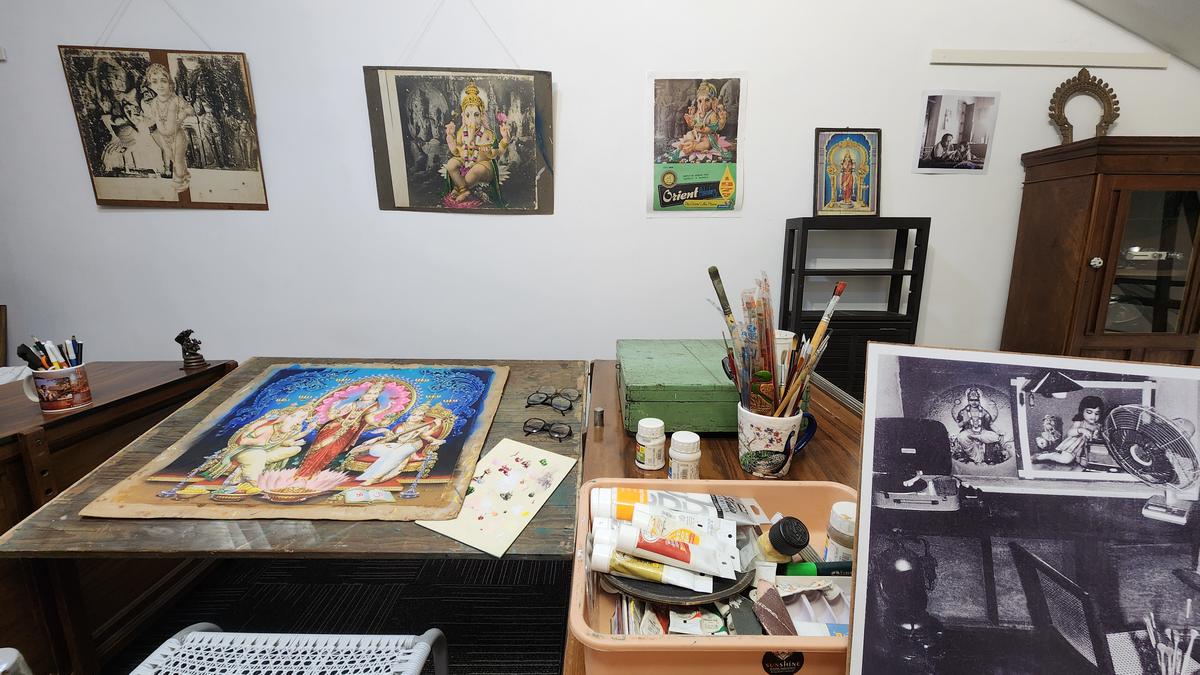
Tamil Nadu’s Kovilpatti, home to India’s traditional calendar art revolution
The Hindu
One of the pivotal movements of Indian calendar art traces its origin to Tamil Nadu’s Kovilpatti. Meet the patrons and artists who are trying to preserve this artform, which boasts exceptional hand-drawn skills
Vyjayanthimala clad in an incandescent green saree teases a glance as a fish bowl and its silvery-gold inhabitants in the background stand witness. This canvas is signed: M Ramalingam. An archetype of 1980s Tamil cinema and its dramatic allure, this frame frozen in paint, speaks volumes: of a glorious time of hand-drawn skills that later morphed into the thriving industry of calendar art in South India. Ramalingam was one of its most prolific stars.
Today, in the bylanes of the dusty, metro work-laden Arcot Road in Chennai is Chithiraalayam, an unassuming gallery brimming with familiar canvases and prints. By familiar, I don’t mean in the style of Razas and Husains. Rather, it is the kind of familiarity you associate with a dear object at home that you have known for decades. In the gallery are many ‘saami padams’ (as they were known in the 1940s) by some of the stalwarts and pioneers of the calendar art industry, all hailing from the school of C Kondiah Raju. Think Muruga with a smile on his face against a glittery backdrop, and other Hindu gods and goddesses, apart from scenes from popular Indian mythology like that of the churning of the ocean.
Chithiraalayam is a study on this school of artists that never got its due and of an industry that faded around the end of the 20th Century. A part of the collection is on display today at DakshinaChitra, as an ode to its forgotten masters.
Calendar art found space in most Indian households in the early 20th Century, as they were often distributed for free by retail stores selling textile, jewellery and sweets ordering calendars to give to customers. But little was known about the hands that drew them. “It is an industry that never got registered in art history,” says KR Jayakumar, the youngest son of Ramalingam whose vision for this commercial art gallery is awareness more than revenue: for now, all the works here are only for display and documentation.
As Raja Ravi Varma, one of the pioneers of popular art in the country, earned steady acclaim for bringing European academic art styles onto Indian themes, and portraying characters from The Mahabharata and the The Ramayana, a quieter revolution was underway in the sidelines, impinged on portraying divinity.
The legacy goes back to the 1940s when popular art in Kovilpatti got a name under C Kondiah Raju who started out by painting backdrops for travelling theatre companies. Shortly after, he set up photo studios (Sri Ambal Arts in 1944 and Devi Art Studio in 1946) that would see a rush for portraits, which were often drawn in or finished up by the fine hand skill of his students: TS Subbiah, S Meenakshisundaram, TS Arunachalam, M Ramalingam, G Shenbagaraman, M Sreenivasen and TS Rajagopal Raju.
Then came Muruga purnas (different manifestation of lord Muruga) and Hindu mythological scenes, a lot of them dominated by goddesses. “There has always been a tension and thus an attraction to the female as a deity and as a beauty,” says Stephen Inglis, a professor at Carleton University in Ottawa, Canada. “As an anthropologist studying potter communities in Madurai/Ramnad, I saw popular imagery everywhere: in temples, schools, shops, and people’s homes. I wanted to know more,” says Stephen, who is also the curator of the show at DakshinaChitra.

Thomas Jefferson and Abraham Lincoln are two of the greatest presidents that the U.S. has seen. You probably know that already. But did you know that Jefferson made what is considered the first contribution to American vertebrate paleontology? Or that Lincoln is the only U.S. president to receive a patent? What’s more, both their contributions have March 10 in common… 52 years apart. A.S.Ganesh hands you the details…












